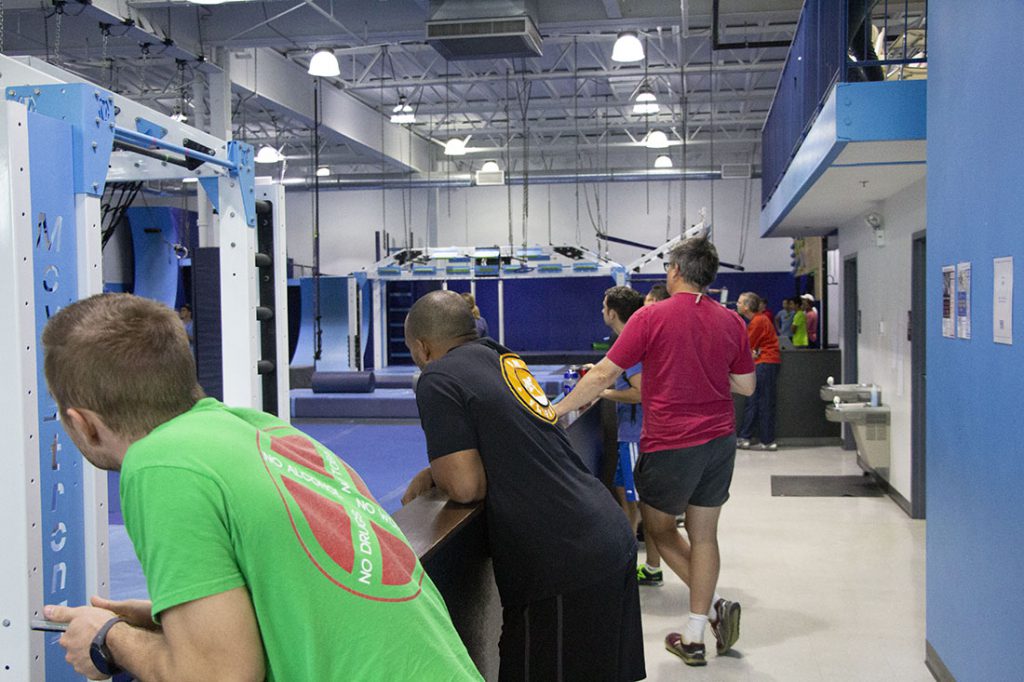By Junie Burns
Medill Reports
Initially, American Ninja Warrior structured its TV presence so that the top Americans could compete in Japan. But as the show gained popularity and athletes became more skilled and aggressive, the show catapulted into a larger market, leaving NBCUniversal affiliate G4 for a new home on NBC ‘s prime time schedule.
Japan began airing a ninja-style sports entertainment special in 1997 where 100 athletes competed on a rigorous four-stage obstacle course called “Sauske.” G4 adapted this format in the United States to create American Ninja Warrior.
Now, the success of the television show carries over into local gyms and ninja gyms while competitive leagues continue to pop up across the country. Patrick Losch, co-owner of the Hanover Park ninja gym Muscleball Ninjas, is the co-founder of Athlete Warrior Games, one of the up-and-coming ninja warrior competitive leagues based in the Midwest.
Losch, a native of Illinois, trained at Muscleball Ninjas for six years before launching Athlete Warrior Games with gym co-owner and 5-time American Ninja Warrior veteran Tyler Yamamuchi.

Q&A with Athlete Warrior Games co-founder Patrick Losch:
How did Athlete Warrior Games get started?
Losch: I co-own a gym with Tyler Yamauchi, who’s been on American Ninja Warrior for five seasons. We found that there weren’t enough competitions in the [Chicago] area. There was only one gym that would do an elite competition and then another gym might do an elite competition, but the places were so far apart that there wasn’t enough consistent competition for athletes from this area. So we said, “Okay, let’s create a league for the gyms in Illinois just so we have something locally so our people can keep competing, keep their skills up, and so on and so forth.”
What was it like to get gyms involved?
Losch: Initially, we weren’t getting as much from gyms in the area, so we decided to do a quick 3-hour radius of Chicago and whatever gyms land in that area, we’ll invite them. So that’s how we landed with 16 gyms in the Midwest [for the first season of competition] with Indiana, Wisconsin, Michigan and Illinois. We had a really successful first season and it went better than we had expected. Financially, we did well and didn’t lose any money, so it was a plus for a business/start-up.
Then we said, let’s see if we can go bigger. We’ll invite any gym and whoever wants to be a part of it, great. [For this current season,] we ended up with about 50 gyms this year to triple our numbers from the first season. We ended the first season at the end of January, and then we started again in April. Basically, we’ve just been working nonstop to get everything to still run smoothly and for people to understand the rules.
Now we’re at the spot where we have a good following and we’re pretty well respected in the community. I don’t know if we’ll get any bigger or not. It’s just about making sure that there’s more time for athletes and more competitions for them.
You mentioned that there’s some traction building around turning Ninja Warrior into an Olympic sport – what has that process been like?
Losch: Bob Clark, who’s in charge of UNAA (Ultimate Ninja Athlete Association ), has the biggest foothold in the whole process of starting to make ninja warrior into an Olympic sport. He has the communication with the OCR – Obstacle Course Racing – Federation. The UNAA has already put bids in to the Olympics to try to get an event. This year, they finally got an exhibition. So they’re gonna set up an exhibition of what obstacle course racing would look like at the Olympics. [Bob is] trying to roll that out.
The next hang-up was how many events would they have. For example, gymnastics would be boring if it were only one event so they had to create more events. It’s the same thing for OCR. The Olympic Committee told Bob they have to create more events to become an Olympic event. They had Obstacle Course Racing, and they’ll add Ninja Warrior, and now what else can they add?
Bob has done the most work, he has the most research put into it, he’s invested the most money in trying to make it happen. The most common hang-up is that you have to have [75 countries on four continents] doing competitive ninja warrior to make it an event and he has enough countries doing his competitions to make that happen. I’ve spoken to him a bunch of times about it and he’s asked me to come on board to help with it, so I would be honored to be in that process.
Whatever happens after the 2020 Olympics, the next exhibition would be the next step for them. It’s getting closer, but that OCR process has taken 10-15 years of repeated bids to try to get it there. I don’t think it’ll happen soon, but there’s definitely some headway to make it happen.
Did you ever think you’d know this much about the Olympic process?
Losch: If you would’ve told me when I walked into a gym six years ago that I would know half of the things I know now just from deciding to start a ninja warrior league? The things I’ve got going on behind the scenes of Ninja Warrior are bigger than the things that go on in Ninja Warrior. I was just some guy who built something in his backyard. That’s how I started, I just wanted to have fun. Now it’s becoming much more of a business than I ever thought it could be. So it’s quite a turnaround for everyone really. It’s cool, it’s scary, it’s a lot of things.


